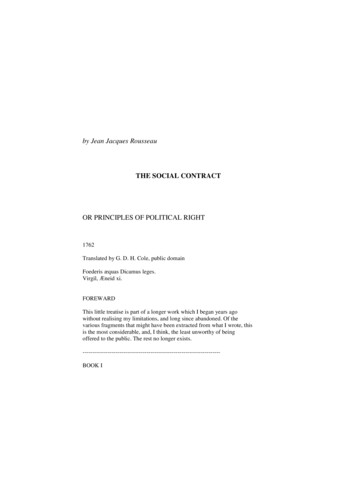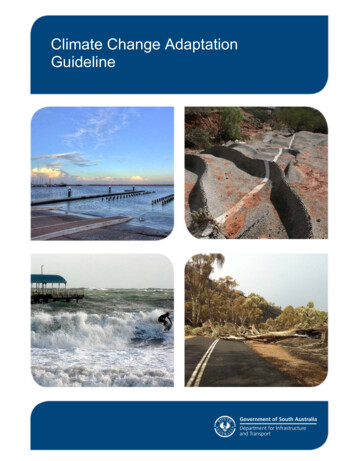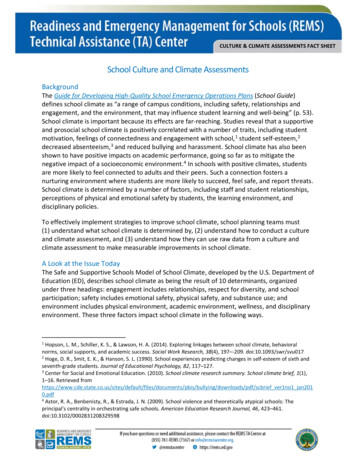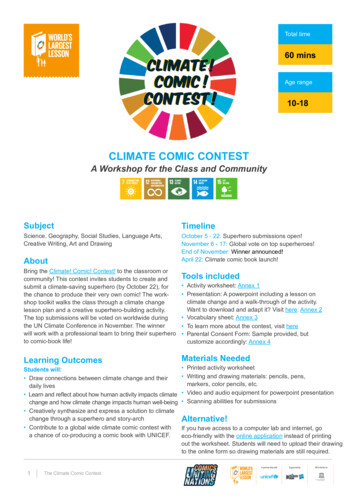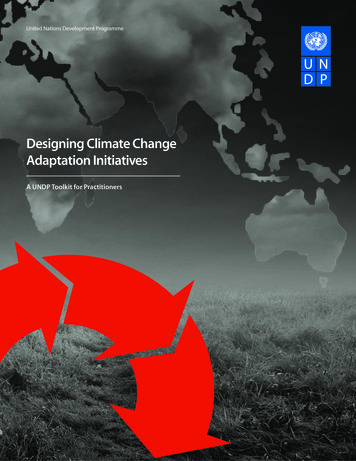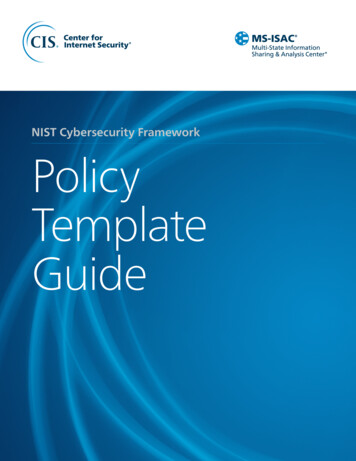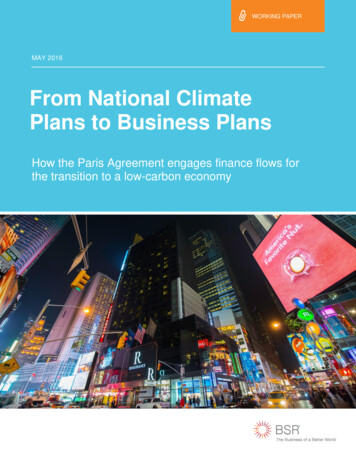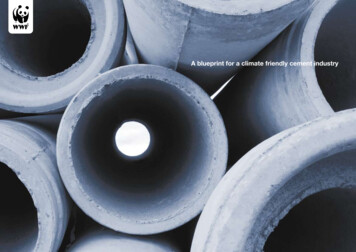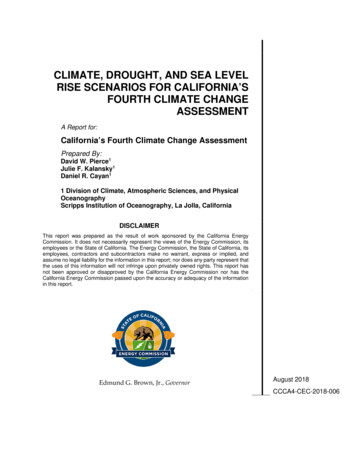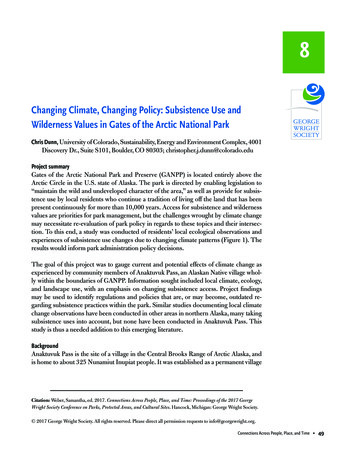
Transcription
8Changing Climate, Changing Policy: Subsistence Use andWilderness Values in Gates of the Arctic National ParkChris Dunn, University of Colorado, Sustainability, Energy and Environment Complex, 4001Discovery Dr., Suite S101, Boulder, CO 80303; christopher.j.dunn@colorado.eduProject summaryGates of the Arctic National Park and Preserve (GANPP) is located entirely above theArctic Circle in the U.S. state of Alaska. The park is directed by enabling legislation to“maintain the wild and undeveloped character of the area,” as well as provide for subsistence use by local residents who continue a tradition of living off the land that has beenpresent continuously for more than 10,000 years. Access for subsistence and wildernessvalues are priorities for park management, but the challenges wrought by climate changemay necessitate re-evaluation of park policy in regards to these topics and their intersection. To this end, a study was conducted of residents’ local ecological observations andexperiences of subsistence use changes due to changing climate patterns (Figure 1). Theresults would inform park administration policy decisions.The goal of this project was to gauge current and potential effects of climate change asexperienced by community members of Anaktuvuk Pass, an Alaskan Native village wholly within the boundaries of GANPP. Information sought included local climate, ecology,and landscape use, with an emphasis on changing subsistence access. Project findingsmay be used to identify regulations and policies that are, or may become, outdated regarding subsistence practices within the park. Similar studies documenting local climatechange observations have been conducted in other areas in northern Alaska, many takingsubsistence uses into account, but none have been conducted in Anaktuvuk Pass. Thisstudy is thus a needed addition to this emerging literature.BackgroundAnaktuvuk Pass is the site of a village in the Central Brooks Range of Arctic Alaska, andis home to about 325 Nunamiut Inupiat people. It was established as a permanent villageCitation: Weber, Samantha, ed. 2017. Connections Across People, Place, and Time: Proceedings of the 2017 GeorgeWright Society Conference on Parks, Protected Areas, and Cultural Sites. Hancock, Michigan: George Wright Society. 2017 George Wright Society. All rights reserved. Please direct all permission requests to info@georgewright.org.Connections Across People, Place, and Time 49
Figure 1. Subsistence user in Gates of the Arctic National Park. Photo by Chris Dunn.in 1949 in response to economic and ecological changes, as well as a desire for outsidetrade and services, like a school, post office, and airstrip. The Brooks Range has been thetraditional homeland of the Nunamiut peoples for 4,000 years.1 Prior to settlement theywere primarily nomadic hunters who followed caribou throughout the range, while alsooccasionally migrating to the Arctic Coast. Much of the traditional Nunamiut homelandwas subsumed into GANPP when it was created in 1980 with the passage of the AlaskaNational Interest Lands Conservation Act (ANILCA). ANILCA followed a series of laws,such as the Alaska Native Claims Settlement Act (ANCSA) of 1971, which largely servedto create modern Alaska. ANCSA “extinguished all aboriginal claims to lands and hunting and fishing rights”2 while creating Native regional and village corporations thatwere given land rights and monetary compensation, but also the obligation to integrateinto markets, and to seek profits, significantly altering the relationship that Alaska nativepeoples have with their traditional lands.ANILCA, however, gave native and other rural Alaskans subsistence rights on most federal lands, defining subsistence as “the customary and traditional uses by rural Alaskaresidents of wild renewable resources for direct personal or family consumption as food,shelter, fuel, clothing, tools, or transportation; for the making and selling of handicraftbyproducts of fish and wildlife resources taken for personal or family consumption; andfor customary trade.”3 Subsistence rights were extended to all “rural” residents, not justnative, to ensure survival of physical, economic, and traditional existence (though specifically mentioning native cultural survival).4 (See Figure 2.) GANPP has 10 resident zone50 Connections Across People, Place, and Time
Figure 2. Caribou skin masks are a sought-after handicraft, a tradition that began in Anaktuvuk Pass in the early1950s. Photo by Chris Dunn.communities that have subsistence rights to hunt, trap, fish, and harvest plants in GANPP,including Anaktuvuk, where, of all 10, the Nunamiut depend most on the park, mainlyon caribou.ANCSA was largely passed in the context of the proposed oil developments at PrudhoeBay, and the supporting oil pipeline which would cross the state, followed by ANILCA.The village of Anaktuvuk Pass was at first slated to be outside of the park, but localswanted to be inside, finding “refuge in this white man’s wilderness.”5 (See Figure 3.) Thiswas largely in response to industrial developments like the Hickel Highway, a rough-shodbulldozed path built in 1969, which ran right through Anaktuvuk Pass, with the intent ofblazing a trail for the Prudhoe pipeline. The pipeline and access road were completed in1977, ultimately following a different route that did not pass through Anaktuvuk.The residents of Anaktuvuk Pass Village continue to follow subsistence lifeways, thoughin a modern and changing context. Two of the greatest changes are the incorporation ofthe Nunamiut into regional native and village corporations, and the adoption of new technologies, including the all-terrain vehicle (ATV), and especially the Argo, first used bythe Nunamiut in the 1970s. ATV use was initially restricted by the National Park Service(NPS) to specific corridors to minimize impacts and prevent the unregulated spread ofmotorized travel. Over time however ATVs began to be seen by locals as necessities forsubsistence activities. This heightened tensions between the NPS and the village until1996, when a land exchange between GANPP and the Nunamiut Village CorporationConnections Across People, Place, and Time 51
Figure 3. Different user groups may have different conceptions of wilderness, such as these backpackers in theArrigetch Peaks. Photo by Chris Dunn.was implemented by Congress. Traditional hunting patterns, including those utilizingATVs, could continue, in exchange for limiting development in the park and allowingrecreational use.6 This land exchange helped preserve prior conceptions of what wilderness is and should be, including allowed uses in wilderness, while meeting the needs anddesires of the local community, healing many early tensions.The issue however is complicated and ongoing. Alaska subsistence is understood in ANILCA to be a complex mix of traditional and modern practices. ANILCA allows nonconforming, pre-existing (prior to 1980) uses, specifically mentioning snow machines, motorboats, and planes (if traditionally employed), but not mentioning ATVs. “Traditional”use includes subsistence and access to homesites and inholdings. This is required “to assure adequate and feasible access for economic and other purposes.” The issue becomesmore complex when questions arise, such as what is “adequate” (could travel by foot,dogsled, or airplane be used instead) and “feasible” (is it both possible and consistentwith purposes of ANILCA)? Is recreation a traditional activity? How does “traditional”apply to use versus technology?This last question is answered in part by a Senate report on ANILCA, which states that“restriction of subsistence to customary and traditional uses shall ‘in no way impede theuse of new technology for subsistence purposes.’”7 This could be read to apply to ATVs.However, ANILCA mandates preservation of “wilderness resource values.” A 2002 request by a native resident asking for ATV access through GANPP wilderness to an allot52 Connections Across People, Place, and Time
ment historically accessed by plane and snow machine was denied by NPS after conducting an environmental assessment that concluded that ATV impacts can be severe, andthat the Anaktuvuk Land Exchange of 1996 disallowed ATV use.8Anaktuvuk Pass Village offers an alternate vision of wilderness: an inhabited homeland.This presents challenges to larger narratives defining parks and wilderness, but GANPPseems to have found a balance. On the one hand, the park is 80% designated wilderness,and they describe themselves as a premier (also flagship and black-belt) wilderness park.GANPP also acknowledges the prior and continuing human history: “People have been apart of the ecosystem here for over 13,000 years. Nomadic hunters and gatherers traveledbetween the mountains’ forested southern slopes and the Arctic Coast. Now their descendants depend on and use park and preserve resources.”9Wilderness that includes subsistence use is not an altogether new idea. Mt. McKinleyNational Park (now Denali NP) was created in 1917 and initially allowed subsistencehunting by local miners. This did not last long, however, since the miners turned out tobe poor stewards.10 ANILCA institutionalized and greatly expanded this managementchallenge. Meanwhile, subsistence and alternative uses are allowed in several non-Alaskanparks, including Badlands National Park, Point Reyes National Seashore, Voyageurs National Park, Grand Canyon National Park, and Death Valley National Park.11Subsistence is the primary arena where park management most directly affects Anaktuvukresidents. There seems to be a reasonably high degree of participatory management structured around subsistence. Subsistence Resource Commissions (SRCs) allow communityrecommendations to be factored into management decisions. Additionally, various parkstaff visit communities, and an Anaktuvuk-based park ranger attends city council meetings and acts as general liaison.A crucial challenge for subsistence management could be the cultural and spiritual valuesthat are deeply embedded in this traditional lifeway. Traditional native worldviews ofteninclude an understanding of nature as inspirited, a view traditionally shared by the Nunamiut.12 This likely persists at some level, despite a widespread adoption of Christianity.Outside stakeholders, such as guides and some park staff, may not always fully appreciatethis, which could at times lead to gaps in communication or differing management visions. In other words, epistemological barriers may exist that lead to institutional barriers.An example is that some Alaska natives object to collaring bears since it does not honortheir spirit. The extent to which this applies to the Anaktuvuk case will, however, requirefurther research to determine.GANPP does not receive the volume of visitation of many lower 48, or more accessible Alaskan, parks. Visitation is nevertheless substantial and growing. The populationof Anaktuvuk Pass Village and other rural arctic populations is also growing, if slowly.13Meanwhile technology that allows for both subsistence and recreational use, both mechanized and non-mechanized, is improving and allowing for greater and easier access intothe park. Each user group may have a different vision of what wilderness is and a differentset of expectations. The two groups do not typically collide, particularly since subsistence use from Anaktuvuk residents is primarily confined to areas surrounding the village.There nevertheless exists an increasing potential for conflict.Connections Across People, Place, and Time 53
Perhaps the most significant challenge to wilderness and to the Nunamiut, and the relationship that they have with GANPP wilderness, comes from climate change. This presents unique challenges and amplifies prior concerns. Examples include changing weatherpatterns which affect temperature and snowfall. This can make snow machines less effective, and shorten their useful season. This in turn motivates locals to turn to greater ATVuse, giving rise to many of the issues previously discussed. When the ground is not frozen,as is increasingly the case, ATVs have a greater impact. Another key issue is changingtiming and location of animal presence and migration, especially caribou. The caribou areno longer coming through Anaktuvuk in the same way they did in the past, thus forcinglocal residents to travel further from town, increasingly butting up against the wilderness.Alaska natives, including the Nunamiut of Anaktuvuk Pass, face many challenges, including their identity as it spans the worlds of corporate America and traditional subsistenceculture. They must come to terms with modernity and the globalized connectivity posedby economics and technology. Climate change is affecting the Arctic more than any placeon Earth and posing new, less predictable, and often detrimental realities that the peoplewho reside there must face. Meanwhile, all of this must be done in the context of protected landscapes governed by bureaucratic structures: “Wilderness managers, advocates,and those living in and around wilderness must come to terms with the undeniable truththat humans are a part of the wilderness landscape in Alaska. Determining the appropriate context within which this relationship exists, however, remains to be determined.”14Summary of major themesThe following is a very brief synopsis of ethnographic fieldwork, including previously recorded interviews with Anaktuvuk Pass residents from the 2008 videos, Voices of the Caribou People,15 which includes five interviewees who specifically mention observations oflocal changes including subsistence access. In one summer month in 2016, I conductedfour complete, in-person interviews of seven people, and had many informal interactions,including through participant observation in Anaktuvuk Pass. All interviewees were active subsistence users, all above the age of 30, with a majority being elders over the age of70. All of these interviewees had at least some experience with subsistence in the Anaktuvuk Pass area (at a young age) that they could draw upon as a point of comparison againstcurrent conditions, as well as relevant cultural memories. Additionally, I conducted onephone interview with a longtime active subsistence user and resident of Wiseman, as anadditional source of information that may shed some light on the Anaktuvuk situation.Snow machine access. “The summers grew longer where I can have my machine maybeeight months out of the year and you have only four months of good, hard snow butglobal warming might be some changes in some of our seasons because I can go out longer with my eight-wheeler than before my uncles and my grandpas used to have.” Snow machine season is impeded for about a month on either side (spring andfall); it can be extended but with more hazards (especially exposed rocks andopen creeks), which may entail higher maintenance costs.True loss is about one week in both fall and spring (“That’s quite a change.”).Animals. Caribou: last big migrations were in the late 1990s, early 2000s (or earlier)54 Connections Across People, Place, and Time
Reasons given: sport hunters, oil development, industrial noise, decrease in lichen, hunting habits of other villages or Anaktuvuk residents (not allowing thefirst “trail makers” to come through unimpeded), and perhaps also inadvertentencounters with hikersChanging habitats for other animals, including northward expansion of, for example, otter, beaver, and lynxWeather. “No real for-sure anymore.” “Never would have been like that before.” “Thingsare getting more and more random.” Warmer, drier summers; warmer, shorter wintersWinter rain: notable rain events in October 2014 and December 2013 (or perhaps 2014)Negative effects on, for instance, caribou, trapping, and snow quality; for example, ice coating traps making them ineffective, or coating snow making lichenhard to access for caribouIce. “No way you sure you’re on the right river?. Huh, never used to be that way.”There is thinner, less reliable river and lake ice. Permafrost effects are relatively minimaldue to location, but some unusual ground ice formations reported.Understandings of climate change as a scientific phenomenon. Belief in climate changeis almost universal, but there are widely divergent conceptions of what exactly it entails: On multiple occasions, causation is attributed to shift in position of earth (sunhigher in the horizon).On one occasion, a direct correlation with earthquakes was made.Risk perception. There is a general lack of significant concern, along with a strong beliefin people’s ability to adapt.Other. The 2007 tundra fire north of town was widely cited as, and understood to be,unusual.Endnotes1. V.A. Mathews, “Case Study of a Homeland and a Wilderness: Gates of the Arctic National Park and the Nunamiut Eskimos” (master’s thesis, University of Alaska, Fairbanks, 1990), 15–16.2. Alaska Native Claims Settlement Act, Public Law 92-203, U.S. Code 43 sec. 1601–1624.3. Alaska National Interest Lands Conservation Act, Public Law 96-487, U.S. Code 431602–1784.4. Lynn Ross-Bryant, Pilgrimage to the National Parks (New York, NY: Routledge,2013), 211.5. Ibid., 213.6. Randy Tanner, “Subsistence, Inholdings, and ANILCA: The Complexity of Wilderness Stewardship in Alaska,” International Journal of Wilderness 10, no. 2 (2004): 4.7. Senate Report, Energy and Natural Resources Committee, no. 96-413, Nov. 14,1979.Connections Across People, Place, and Time 55
8. Tanner, 4.9. Gates of the Arctic, homepage, accessed December 12, 2015, www.nps.gov/gaar/index.htm.10. Ross-Bryant, 209.11. Ross-Bryant, 213–14.12. James Gladden, “Bioregionalism as an Arctic Wilderness Idea,” Worldviews: Environment, Culture, Religion (1999): 7.13. Ibid, 3.14. Tanner, 5.15. “Voices of the Caribou People,” Archana Bali, Circum-Arctic Rangifer Monitoringand Assessment Network, on-line video collection, recorded 2008, accessed August15, 2016, https://voicesproject.caff.is/index.php.56 Connections Across People, Place, and Time
Anaktuvuk Pass Village offers an alternate vision of wilderness: an inhabited homeland. This presents challenges to larger narratives defining parks and wilderness, but GANPP seems to have found a balance. On the one hand, the park is 80% designated wilderness, and they describe themselves as a premier (also flagship and bla


